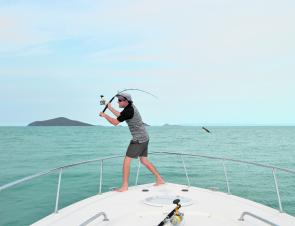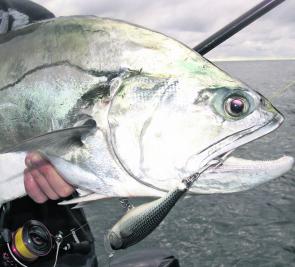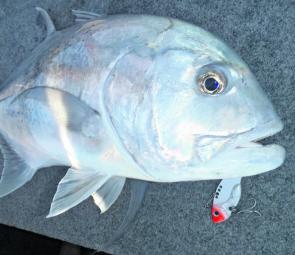February is a productive time to fish around the Whitsundays with plenty of species on offer. The many islands will be producing active pelagic fishing. So, if you’re into sportfishing, this month should provide you with ample to keep you busy.
The three usual suspects should be around in numbers this month; GT, golden trevally and queenfish. These fish would have to be the most common pelagic found in the area. In saying that, they also rank among the most popular. And the bigger they get, the more of a trophy catch them become.
GT, goldens and queenies, as they are commonly known as, can be found on basically every island – they are very nomadic and spend a lot of their time roaming the vast depths. But just because they can be found everywhere, that doesn’t mean they’re easy to find – or catch for that matter. You need some knowledge of pelagic fish habitat to be able to recognise the types of locations they prefer to frequent.
When searching for big, hungry pelagic fish, you should always be on the lookout for large schools of baitfish. Whether it be garfish, herring, mullet, etc, the larger the amount of baitfish, the more chance you have of finding predatory pelagics nearby. We’ve had some of our best pelagic fishing sessions after finding enormous amounts of tightly packed baitfish.
Finding fish holding structure or cover is another way of locating these pelagics. This includes fringe bommies, reef drop-offs, rocky headlands, fallen boulders, reefs and wrecks. Although these three species appear commonly in shallow water, many of the larger specimens spend most of their days lurking and haunting the dark depths. Large, wily old fish – the true trophy’s of the sea – find more comfort in the deep. So when you’re searching for these pelagics, try to find structure or cover that is close to or in deep water. Generally, the larger the structure and the deeper the water, the more chance there is of big pelagic fish showing up.
We recently took a look at a map that marked out the movements of a GT which had a tracking tag attached to it. The path of this fish was quite amazing – the best word to describe its movements would be something like ‘wild’ or ‘erratic’ – it was certainly all over the place!
However, it was interesting to see that the fish did return to previously visited locations quite consistently, but also travelled long distances, covering lots of terrain. It goes to show just how much these fish travel. A fish that you caught in the morning could be many, many kilometres away when night approaches.
If it’s way too rough offshore and you’re keen for a fish, there’s quite a few inshore locations that regularly produce solid fish.
The large moored yachts and cruisers out from Abel Point Marina often hold quality fish underneath the hulls. The shade and cover that they provide often attracts a variety of species from queenfish, mid-sized GT, some mackerel species and even reef fish at times. These places are nice and close to the VMR boat ramp so you can access them in a small tiny or even a kayak.
We’ve had some great sessions around the rock walls, boats and jetties in our Hobie Pro Angler kayaks. You seem to be able to catch more fish in a kayak as they are much lower to the water and very quiet – much stealthier than a boat. This suits areas where the fish are more accustomed to boat traffic and have become picky.
If you don’t have access to a boat, that’s no problem. There’s still plenty of fishy terrain that’s accessible from the shore. The rock walls near the VMR station often produce barramundi, golen snapper and trevally species, especially around the dawn and dusk/after dark periods. On a recent expedition, we saw GT up to around 23kg and several barramundi from 60-80cm around the area.
The fishing platform at Shute Harbour is another good spot as the jetty is situated in a productive location, with a nice, deep channel running alongside it. Anglers have landed huge GT, mackerel and plenty of large queenfish here in the past.
Reads: 2547
Pumping out a cast in search of a large Whitsunday GT.

There’s plenty of light tackle fishing for estuary and pelagic fish inshore. This makes kayak fishing a great option.

This solid queenfish was caught on a Rapala Skitter Pop burned over the surface at speed.

There should be plenty of active GT fishing on offer this month, especially around the islands and reefy structures.




